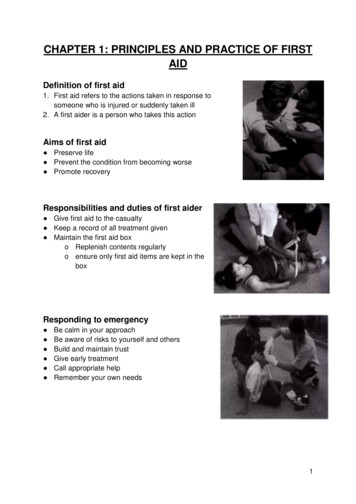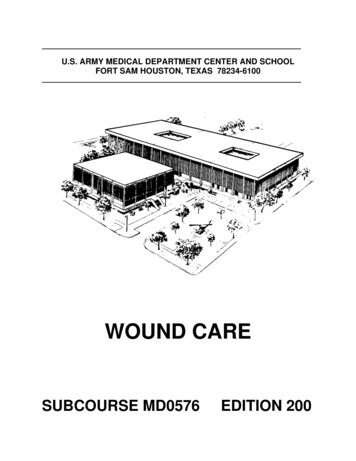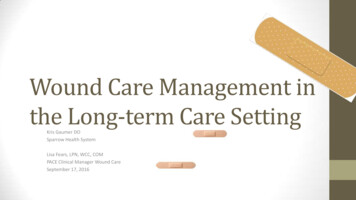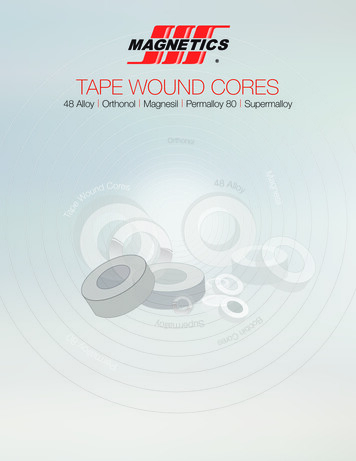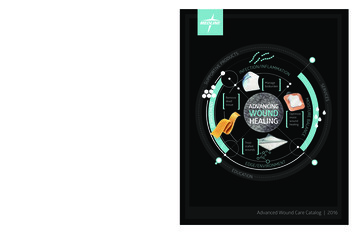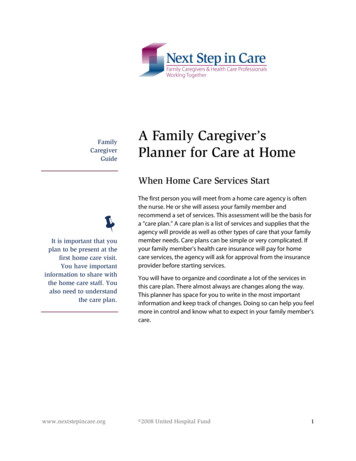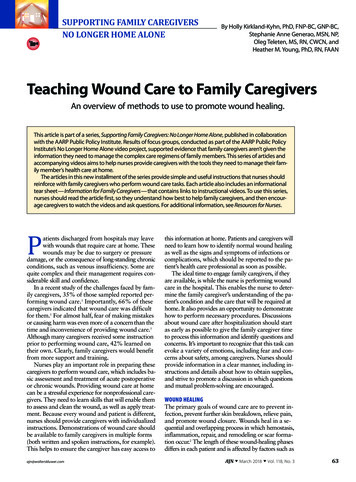
Transcription
SUPPORTING FAMILY CAREGIVERSNO LONGER HOME ALONEBy Holly Kirkland-Kyhn, PhD, FNP-BC, GNP-BC,Stephanie Anne Generao, MSN, NP,Oleg Teleten, MS, RN, CWCN, andHeather M. Young, PhD, RN, FAANTeaching Wound Care to Family CaregiversAn overview of methods to use to promote wound healing.This article is part of a series, Supporting Family Caregivers: No Longer Home Alone, published in collaborationwith the AARP Public Policy Institute. Results of focus groups, conducted as part of the AARP Public PolicyInstitute’s No Longer Home Alone video project, supported evidence that family caregivers aren’t given theinformation they need to manage the complex care regimens of family members. This series of articles andaccompanying videos aims to help nurses provide caregivers with the tools they need to manage their family member’s health care at home.The articles in this new installment of the series provide simple and useful instructions that nurses shouldreinforce with family caregivers who perform wound care tasks. Each article also includes an informationaltear sheet—Information for Family Caregivers—that contains links to instructional videos. To use this series,nurses should read the article first, so they understand how best to help family caregivers, and then encourage caregivers to watch the videos and ask questions. For additional information, see Resources for Nurses.Patients discharged from hospitals may leavewith wounds that require care at home. Thesewounds may be due to surgery or pressuredamage, or the consequence of long-standing chronicconditions, such as venous insufficiency. Some arequite complex and their management r equires considerable skill and confidence.In a recent study of the challenges faced by family caregivers, 35% of those sampled reported performing wound care.1 Importantly, 66% of thesecaregivers indicated that wound care was difficultfor them.1 For almost half, fear of making mistakesor causing harm was even more of a concern than thetime and inconvenience of providing wound care.1Although many caregivers received some instructionprior to performing wound care, 42% learned ontheir own. Clearly, family caregivers would benefitfrom more support and training.Nurses play an important role in preparing thesecaregivers to perform wound care, which includes basic assessment and treatment of acute postoperativeor chronic wounds. Providing wound care at homecan be a stressful experience for nonprofessional caregivers. They need to learn skills that will enable themto assess and clean the wound, as well as apply treatment. Because every wound and patient is different,nurses should provide caregivers with individualizedinstructions. Demonstrations of wound care shouldbe available to family caregivers in multiple forms(both written and spoken instructions, for example).This helps to ensure the caregiver has easy access toajn@wolterskluwer.comthis information at home. Patients and caregivers willneed to learn how to identify normal wound healingas well as the signs and symptoms of infections orcomplications, which should be reported to the patient’s health care professional as soon as possible.The ideal time to engage family caregivers, if theyare available, is while the nurse is performing woundcare in the hospital. This enables the nurse to determine the family caregiver’s understanding of the patient’s condition and the care that will be required athome. It also provides an opportunity to demonstratehow to perform necessary procedures. Discussionsabout wound care after hospitalization should startas early as possible to give the family caregiver timeto process this information and identify questions andconcerns. It’s important to recognize that this task canevoke a variety of emotions, including fear and concerns about safety, among caregivers. Nurses shouldprovide information in a clear manner, including instructions and details about how to obtain supplies,and strive to promote a discussion in which questionsand mutual problem-solving are encouraged.WOUND HEALINGThe primary goals of wound care are to prevent infection, prevent further skin breakdown, relieve pain,and promote wound closure. Wounds heal in a sequential and overlapping process in which hemostasis,inflammation, repair, and remodeling or scar formation occur.2 The length of these wound-healing phasesdiffers in each patient and is affected by factors such asAJN March 2018 Vol. 118, No. 363
SUPPORTING FAMILY CAREGIVERSNO LONGER HOME ALONEA nurse teaches a family caregiver how to assess a diabetic foot ulcer and safelychange the dressing. Photo courtesy of the AARP Public Policy Institute.advanced age, obesity, and a history of smoking ordiabetes.3-5Prior to the discharge of a patient with a wound,the nurse must formulate recommendations based onthe context and setting in which the care will occur.Caregiver and patient preference must be considered,as should the home environment. The nurse can thenmake recommendations that help to promote adherence.DRESSING CHOICEDressings should help to keep the skin surroundingthe wound dry and intact. The dressing should bebreathable to avoid maceration of surrounding skin.Conversely, too much dryness of an open woundcan lead to a dry eschar overlying the wound bed,increasing pain and delaying healing.Treatment of open wounds aims to alleviate symptoms, promote healing, and prevent adverse outcomes,such as infection, amputation, pain, and disability.Dressings used on deep or complex wounds are oftendesigned to address moisture balance and promote debridement and may be antimicrobial.6SURGICAL INCISIONSSurgical incisions are considered acute wounds andheal through primary intention unless there is dehiscence or a delay in healing. During surgery, the woundedges are approximated and sutured, glued, or stapled together. Nurses caring for patients after surgeryshould engage both patients and family caregivers in64AJN March 2018 Vol. 118, No. 3efforts to prevent surgical site infections and promotehealing.Treatment. In patients who have wounds that havebeen sutured, stapled, or glued closed, the surgeon typically recommends showering within 12 to 48 hours ofsurgery. The caregiver should then pat the wound dryusing gauze, a clean towel, or a paper towel.The wound is usually covered with a sterile dressingimmediately after surgery. Early dressing of the woundis important to absorb any leakage and to protect thewound from trauma and infection. Postoperativewounds typically require a clean dry gauze dressing.An absorbent dressing is needed if the wound is leaking fluid, and a protective dressing is necessary if thewound is exposed to abrasive clothing (and, in somecases, to relieve pain). A nonadherent absorbent gauzeor silicone dressing is sufficient for most postoperativeincisions or lacerations.7 In the case of postoperativewounds that develop excessive exudate, there arenewer, highly absorptive foam dressings that can bechanged every four to seven days, or sooner if discharge penetrates the dressing.6, 8Family caregivers should be instructed not to useantiseptics or other products on a surgical woundunless told to do so by a health care provider. In addition, the wound should not be soaked in water.Skin damage to the periwound skin—macerationand impaired wound healing—may occur if the areais exposed to excess drainage from the wound. Caremust be taken to avoid the use of adhesive tape onfragile skin when securing the dressing. If available,use silicone tape to secure the dressing to the skin;when possible, attach tape to a gauze wrap placedover the dressing.VENOUS ULCERSVenous ulcers occur on the legs. Approximately 70%of leg ulcers are due to venous insufficiency.9 Venousleg ulcers are a result of inflammation caused by venous hypertension in the lower extremities.10 Afterthey are healed, most venous ulcers recur and needcontinuous monitoring and treatment to prevent disability and amputation.11Because of the complex needs of people with venous ulcers, these patients are typically referred to awound care specialist. This care should be supplemented by nurse engagement with the caregiver andpatient regarding home wound care.Prevention. Obesity and venous stasis contribute tothe development of venous ulcers. A weight loss planthat includes a focus on wound healing and the promotion of exercise should be developed with caregiverand patient input. Because exercise can improve hemodynamic performance and prevent ulcer recurrence,many venous ulcer management programs encourageajnonline.com
Information for Family CaregiversWound Care Wash hands before and after changing a dressing. Wear gloves during all dressing changes. Dispose of the old dressing in a plastic bag before placing it into the garbage. Cleanse the wound before applying a new dressing. The wound can be cleansed by the patient using water in theshower, or by the caregiver, who can spray saline on the wound to clean oot UlcersAssessmentPrevention and TreatmentDuring every dressing change, The patient should shower percheck forthe surgeon’s orders. redness. No baths until they are cleared by swelling.the surgeon. a change in wound drainage Use prescribed dressings (usually(color or amount).a plain or silicone nonstick dressing). separation of wound edges. increased pain.During every compressionThe patient shouldbandage change, check for wear daily compression bandages. redness. lose weight, if overweight. swelling. follow a walking regimen. a change in wound drainage change dressing as prescribed.(color, odor, or amount). elevate legs for 30 minutes, three increased pain.times per day. Check between toes for Inspect the patient’s feet daily.any maceration, redness, or Practice daily foot hygiene.breaks in the skin. Practice good skin care, including Monitor the temperature ofthe use of alcohol-free moisturizers.the feet. Control blood sugar levels. Ensure footwear fits properly. Obtain regular toenail care by aprofessional. Use off-loading techniques tomanage wounds. Before putting on shoes, checkthe inside for irregular, sharp surfaces or foreign objects.When to Contact a Health CareProviderContact a health care provider if the patient has a fever or thechills. if there is an increased amountof pain, swelling, or redness. if the wound separates. if there is a change in wounddrainage (color, odor, or amount).Contact a health care provider if the patient has a fever or thechills. if there is an increased amountof pain, swelling, or redness. if there is a change in wounddrainage (color, odor, or amount).Contact a health care provider if the patient has a fever or thechills. if there is an increased amountof pain, swelling, or redness. if there is a change in wounddrainage (color, odor, or amount). if calluses develop. These shouldonly be removed by a professional.Family caregiver instructional videos about wound care can be found on AARP’s website:Diabetic Foot Care: Treatment and Preventionhttp://links.lww.com/AJN/A107General Principles of Wound Carehttp://links.lww.com/AJN/A105Caring for Lower Extremity Wounds and Cellulitishttp://links.lww.com/AJN/A106For additional information and to access these videos in Spanish, visit AARP’s Home Alone Alliance web page: N March 2018 Vol. 118, No. 365
SUPPORTING FAMILY CAREGIVERSNO LONGER HOME ALONEDIABETIC FOOT ULCERSResources for NursesDiabetic Foot Care: Treatment and Preventionahttp://links.lww.com/AJN/A109General Principles of Wound Careahttp://links.lww.com/AJN/A110Caring for Lower Extremity Wounds and Cellulitisahttp://links.lww.com/AJN/A111AJN’s resource page for supporting family caregivers includes previousarticles and videos in this series.http://links.lww.com/AJN/A81aFamily caregivers can access these videos, which are available in English or Spanish, as well as additional information and resources, on AARP’s Home Alone Alliance web page: www.aarp.org/nolongeralone.ambulatory patients to develop regular walking regimens. Elevation has also been shown to increase oxygen delivery by improving venous return and reducingedema and healing time.10 Patients should elevate theirlegs for 30 minutes, three times per day.Treatment. Compression bandaging is the mainstaytreatment for venous ulcers. Compression improvesthe return of blood flow from the lower extremitiesand speeds the healing rate of venous leg ulcers.10, 12, 13It’s important that the nurse and family caregiver engage the patient in the treatment plan to improve adherence. The treatment plan should include woundcare instructions, details about pain control options,and tips for how the patient can address the bulkinessof the compression stockings or garments when wearing footwear. The best compression bandage for homeuse is the one the patient will use regularly, so it’s important to find one that best meets the patient’s dailyneeds while also contributing to the healing of woundsand the prevention of future wounds.Compression bandaging is the mainstaytreatment for venous ulcers.It can be difficult for someone with decreased handstrength and dexterity to apply compression bandagesor garments.13 Poorly applied bandages can result inthe swelling of tissue in areas adjacent to the edges ofthe compression bandage and further skin ulcerationin edematous areas. New compression wraps havebeen designed to provide ease of use.66AJN March 2018 Vol. 118, No. 3Approximately 30.2 million American adults—about 12% of the population—are believed to havediabetes.14 Diabetic foot ulcers are the most common complication of diabetes, with an estimated15% of patients with diabetes predicted to developdiabetic foot ulcers during their lifetime.15Multiple risk factors are associated with the development of diabetic foot ulcers: duration of diabetes longer than 10 years; advanced age; a high bodymass index; sex (male); and other conditions, such asretinopathy, peripheral neuropathy, peripheral vascular disease, elevated glycated hemoglobin levels, footdeformities, high plantar pressure, gait instability, andinappropriate foot self-care.16-20 Local foot issues thatcan contribute to diabetic foot ulcers include minortrauma, improperly fitted shoes, the formation of calluses, limited joint mobility, and abnormal plantarfoot pressure.21-24Prevention. Because patients with diabetes oftenhave neuropathy, pain from trauma may go unnoticed. This trauma can result in a skin ulceration ordiabetic foot ulcer. Educational programs can reducethe incidence of foot ulcers among people with diabetes, highlighting the importance of involving both patients and family caregivers in the promotion of healthand well-being. Caregivers should be aware of theneed to frequently inspect the patient’s feet to identifyblisters and cuts; they should also ensure that the patient has well-fitted footwear and uses off-loadingtechniques that can help to prevent and heal foot ulcers. Calluses should be trimmed by a health careprofessional only.Treatment. The primary management goals for diabetic foot ulcers are to avoid infection, obtain woundhealing, and control pain. To achieve this, frequent assessment of the wound, wound cleansing, the application of a protective dressing that promotes a moisthealing environment, and plantar off-loading are necessary.25Off-loading of the wound with specialty boots orcasting is one of the most important components ofmanaging and promoting the healing of diabetic footulcers.26 The gold standard off-loading technique involves the use of a total contact cast. The cast is designed to relieve pressure on the ulcer and redistributethis across the surface of the foot.25 The casting procedure is advantageous because it ensures patients willcomply with treatment; however, this technique is notalways favored by patients.17, 27 The disadvantages ofcasting include the following: it must be applied by anexpert, it is costly and may cause skin irritation if notapplied correctly, it limits daily activities (potentiallyaffecting sleep and bathing routines, for example), itis contraindicated when the patient has an infection,ajnonline.com
and it does not allow for daily skin assessment.17, 27For these reasons, off-loading boots are more commonly used. Health care providers should encouragethe patient to wear an off-loading boot whenever sheor he is bearing weight on the foot.PATIENT AND FAMILY CAREGIVER EDUCATIONTeaching patients and caregivers about the early detection of both local and systemic infections is a priority during the discharge process. The signs andsymptoms of a local wound infection include increased redness, increased pain, wound dehiscence,an increased amount of or change in the color of ex udate, or malodor. The signs and symptoms of systemic infection include fever, chills, and sweating,and a person with diabetes may have increased bloodsugar levels. If any of these symptoms occur, it’s important that the family caregiver is aware of the needto contact a health care professional immediately.Patients and caregivers who receive thoughtful education on skin care become active participants in theplan of care and have greater knowledge about promoting wound healing and preventing infection. Educational interventions are likely to be more effectiveif they are multifaceted and broadly applicable, meeting various health literacy needs. In addition to thevideos featured in this article, nurses can use variouseducational programs and tools—including writtenmaterial, illustrations, images, videos, computer technology, and smartphone demonstration videos—tomeet different learning and language needs and toachieve patient and caregiver engagement in care.7, 28 Holly Kirkland-Kyhn is the director of wound care and OlegTeleten is a wound care specialist, both in the Patient Care Services Department of the University of California, Davis, MedicalCenter in Sacramento, where Stephanie Anne Generao is an NPin the vascular clinic. Heather M. Young is dean of the BettyIrene Moore School of Nursing at the University of California,Davis, and associate vice chancellor for nursing at UC DavisHealth. Contact author: Holly Kirkland-Kyhn, kirklandwalsh@ucdavis.edu. The authors have disclosed no potential conflicts ofinterest, financial or otherwise.REFERENCES1. Reinhard SC, et al. Home alone: family caregivers providingcomplex chronic care. Washington, DC: AARP Public PolicyInstitute; 2012 Oct. ic policy . Gantwerker EA, Hom DB. Skin: histology and physiology ofwound healing. Facial Plast Surg Clin North Am 2011;19(3):441-53.3. Eming SA, et al. Wound repair and regeneration: mechanisms,signaling, and translation. Sci Transl Med 2014;6(265):1-16.4. Evans DC, et al. Nutrition optimization prior to surgery.Nutr Clin Pract 2014;29(1):10-21.5. Pierpont YN, et al. Obesity and surgical wound healing: acurrent review. ISRN Obes 2014;2014:638936.ajn@wolterskluwer.com6. Sood A, et al. Wound dressings and comparative effectivenessdata. Adv Wound Care (New Rochelle) 2014;3(8):511-29.7. Tartari E, et al. Patient engagement with surgical site infectionprevention: an expert panel perspective. Antimicrob Resist Infect Control 2017;6:45.8. Seaman S. Dressing selection in chronic wound management.J Am Podiatr Med Assoc 2002;92(1):24-33.9. Agale SV. Chronic leg ulcers: epidemiology, aetiopathogenesis,and management. Ulcers 2013;2013:413604.10. O’Donnell TF, Jr., et al. Management of venous leg ulcers:clinical practice guidelines of the Society for Vascular Surgeryand the American Venous Forum. J Vasc Surg 2014;60(2Suppl):3S-59S.11. Grey JE, et al. Venous and arterial leg ulcers. BMJ 2006;332(7537):347-50.12. O’Meara S, et al. Compression for venous leg ulcers. CochraneDatabase Syst Rev 2012;11:CD000265.13. White-Chu EF, Conner-Kerr TA. Overview of guidelines forthe prevention and treatment of venous leg ulcers: a US perspective. J Multidiscip Healthc 2014;7:111-7.14. Centers for Disease Control and Prevention. National diabetes statistics report, 2017. Estimates of diabetes and its burden in the United States. Atlanta; 2017. national-diabetes-statisticsreport.pdf.15. Leone S, et al. [Epidemiology of diabetic foot]. Infez Med 2012;20 Suppl 1:8-13.16. Iraj B, et al. Prevention of diabetic foot ulcer. Int J Prev Med2013;4(3):373-6.17. Liden B. Total contact cast system to heal diabetic foot ulcers.Surg Technol Int 2017;30:71-6.18. McEwen LN, et al. Prevalence and risk factors for diabetesrelated foot complications in Translating Research Into Actionfor Diabetes (TRIAD). J Diabetes Complications 2013;27(6):588-92.19. Shahbazian H, et al. Risk assessment of patients with diabetes for foot ulcers according to risk classification consensusof International Working Group on Diabetic Foot (IWGDF).Pak J Med Sci 2013;29(3):730-4.20. Waaijman R, et al. Risk factors for plantar foot ulcer recurrence in neuropathic diabetic patients. Diabetes Care 2014;37(6):1697-705.21. Edmonds ME, et al. Improved survival of the diabetic foot:the role of a specialized foot clinic. Q J Med 1986;60(232):763-71.22. Fernando DJ, et al. Relationship of limited joint mobility toabnormal foot pressures and diabetic foot ulceration. Diabetes Care 1991;14(1):8-11.23. Lavery LA, et al. Predictive value of foot pressure assessmentas part of a population-based diabetes disease managementprogram. Diabetes Care 2003;26(4):1069-73.24. Reiber GE, et al. Causal pathways for incident lower-extremityulcers in patients with diabetes from two settings. DiabetesCare 1999;22(1):157-62.25. Armstrong DG, et al. It’s not what you put on, but what youtake off: techniques for debriding and off-loading the diabeticfoot wound. Clin Infect Dis 2004;39 Suppl 2:S92-S99.26. American Diabetes Association. Consensus development conference on diabetic foot wound care. 7-8 April 1999, Boston,MA. Adv Wound Care 1999;12(7):353-61.27. Prompers L, et al. Delivery of care to diabetic patients withfoot ulcers in daily practice: results of the Eurodiale Study, aprospective cohort study. Diabet Med 2008;25(6):700-7.28. Kirkland-Kyhn H, Teleten O. One institution’s accommodationof the CARE Act. Ostomy Wound Manag 2017;63(6):8-10.AJN March 2018 Vol. 118, No. 367
Skin damage to the periwound skin—maceration and impaired wound healing—may occur if the area is exposed to excess drainage from the wound. Care must be taken to avoid the use of adhesive tape on fragile skin when securing the dressing. If available, use silicone
